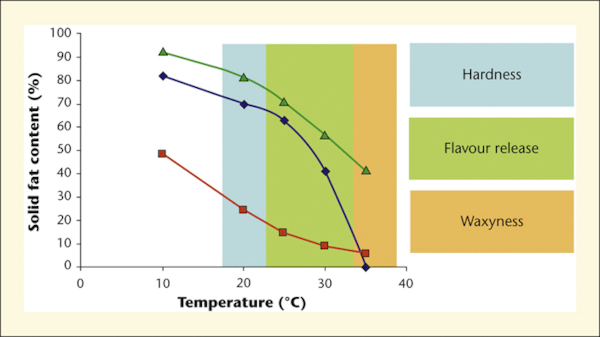Figure 1.

Download original image
The melting behavior of oils and fats is expressed as Solid Fat Content (SFC)(in %) in function of temperature (°C). Different temperature zones can be distinguished in which the fat will have a different effect on the texture and mouthfeel of the food product. The ambient temperature zone will determine the hardness of the product. The temperature zone between 25 and 35̊C is the zone in which the fat will melt and will have an effect on flavor release. The temperature zone around body temperature will determine if all fat will be melted in the mouth or whether still some fat will remain and will result in an unpleasant waxy fat film in the mouth when eating.
The blue curve is a typical curve of cocoa butter. Chocolate is hard at room temperature. When you bite in a bar of chocolate it will be very snappy. Once in your mouth the chocolate will quickly melt, giving an intense flavor release. At body temperature chocolate will be completely melted away.
The red curve is the melting curve of a fat that is soft at room temperature. It will slowly melt away leaving practically no solid fat at body temperature. This is a typical fat that can be used in soft chocolate fillings with a smooth, creamy melting texture sensation.
The green curve is the melting profile of a very hard fat that will slowly melt away and will still leave a large amount of solid fat at body temperature. When this fat would be used as such in a food product, it would give a very bad melting sensation and leave a waxy fat film in the mouth.
Current usage metrics show cumulative count of Article Views (full-text article views including HTML views, PDF and ePub downloads, according to the available data) and Abstracts Views on Vision4Press platform.
Data correspond to usage on the plateform after 2015. The current usage metrics is available 48-96 hours after online publication and is updated daily on week days.
Initial download of the metrics may take a while.




